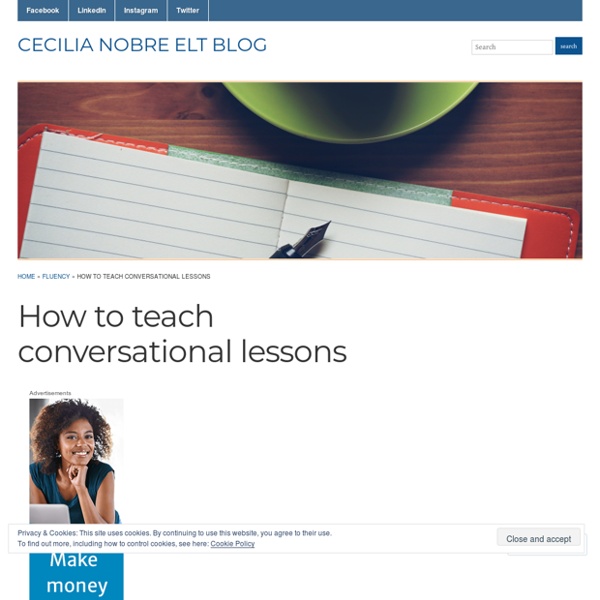Conversation Starters World
Viral Videos for Higher Level ELT | Ian James | @ij64
TARJETAS – eleconole
¡Hola a todos! Como sabéis, me encanta llevar tarjetas a clase: para actividades de role play, vocabulario, juegos de memoria, practicar verbos… en fin, para un montón de cosas. He comprobado que a los estudiantes de todos los niveles y edades les gustan mucho. (Partiendo de la base de que cualquier cosa que sea hacer una actividad que no está en el libro es fiesta). Aquí os iré dejando poco a poco más actividades con tarjetas. ¡Espero que os gusten! Encontraréis muchas más en el blog de ELEInternacional, ya que he creado varias para ellos. Para cualquier duda, sugerencia, crítica, pregunta… podéis escribirme en esta entrada directamente o en cualquiera de las RRSS (Facebook, twitter, Instagam o Pinterest) Un abrazo Ana de Eleconole. Me gusta: Me gusta Cargando...
10-step guide to Teaching Effective Conversation Classes
In this post, I’ll present my 10-step guide for teaching effective conversation classes to adult English learners. Many adult learners enrol in conversation classes to improve their speaking skills. However, student numbers often drop as the course progresses. This can be due to several reasons: Students are not interested in the topics.Students don’t feel they are learning anything new.Students don’t feel they are actually improving their speaking skills.Students want more traditional grammar-structured classes.Students feel they are learning new language rather than practising speaking.Classes lack variety (just question and answer discussions). Conversation classes are not always taken seriously by learners (just chatting), teachers (just listening to learners chatting) or academy owners (promotional tool for paid classes). This is a great shame as conversation classes can be a really effective way to help our learners improve their speaking skills. Step 1: Get to know your learners Task:
Conversation Questions for the ESL/EFL Classroom
If this is your first time here, then read the Teacher's Guide to Using These PagesIf you can think of a good question for any list, please send it to us. Home | Articles | Lessons | Techniques | Questions | Games | Jokes | Things for Teachers | Links | Activities for ESL Students Would you like to help? If you can think of a good question for any list, please send it to us. Copyright © 1997-2010 by The Internet TESL Journal Pages from this site should not be put online elsewhere.Permission is not required to link directly to any page on our site as long as you do not trap the page inside a frame.
8 Fun, No Prep Activities to Rock the New Year in the ESL Classroom – Get Up. Get Out. Get Lost.
Coming back to school after the holidays is tough. Realizing the day before that you haven’t planned anything is worse. Lucky for you, I’ve stock piled a few simple no & low prep activities to get you through the first few days with secondary and the little dudes. Since I see each of my secondary groups just once a week, I often spread New Year activities over a couple of classes. 1. Works best with: High Beginners – Advanced (6º primary, all of ESO & bachillerato)You need: Absolutely nuthin’ If you’re feeling the effects of too much cava & cañas over the holidays, this is the easiest possible way to get started. Warm Up: Tell students 3 things about what you did over the holidays, 2 of which are true and 1 which is invented. 2. Works best with: Intermediate to Advanced (3º ESO & bachillerato)You need: Computer, overhead projector, speakers, video clip This 2015(ish) Jimmy Kimmel clip has been lots of laughs with my students for years! 3. My go to New Year videos for the game are: 4. 5. 2.
8 Google Chrome Extensions you “Add”solutely Need to Use if you are a Teacher
I have been struggling with the title of this post. I wanted to write it in capital letters and tried different angles, all with the same purpose, trying to entice you into reading it as I know for certain that, for some teachers out there, add-ons ( also known as extensions) are still unknown. Introduction Working as a “free app” teacher trainer has taught me quite a lot of things. During these workshops, over the course of a conversation I mentioned, and probably showed, the add-ons I use on Google Chrome to make my work more productive. First of all, the basics What is an add-on or extension? These little icons you see next to the address bar are called add-ons or extensions. How do I install an extension? Just click here and write the name of the extension you want to install. How do I manage my extensions? (it has background music) My favourite Google Chrome Extensions The ones I cannot live without, and in no particular order, are the following: 1. Let’s imagine this scenario. 2. 3. 4. 5.
Socialising 2: Keeping conversations going
After struggling to break the ice, the next obstacle is to keep the conversation going beyond the initial conversation. For this reason, this lesson aims to provide students with a bank of around 15 questions that they would feel comfortable asking in a conversation with a new acquaintance. They will also learn more general techniques involving different types of questions and the skill of turn-taking. Finally, they will practise all the skills from the lesson in a role-play game. Topic: Socialising and keeping conversations going Level: Intermediate (B2) and above Aims: To raise awareness of some techniques for maintaining a conversation with a person you have just met.To analyse the effect of different types of questions, and to practise making different types of question.To come up with and analyse a bank of questions that can be used to keep conversations going.To analyse and practise a technique for turn-taking in a conversation. Plan components Lesson plan: download By Jeremy Day



